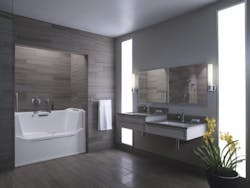Age Proofing a House Isn’t Cheap
Almost one-quarter of Americans will be 65 or older by 2050, and surveys conducted over the past decade show that older adults overwhelmingly want to age in their homes. Yet many houses aren’t suited to “aging in place,” said Abbe Will, associate project director of the Remodeling Futures Program at Harvard.
“Currently, a lot do not have single-floor living — especially in certain parts of country. There are lots of stairs and multistory homes when land is more valuable,” she said. And “many homeowners don’t necessarily have the funds to do aging in place.”
Home modifications and costs vary widely — starting with those simple safety features in the bathroom or lever doorknobs throughout the house — to more extensive changes, such as widening doorways or lowering light switches to wheelchair height. Will said simple retrofits, such as grab bars, “could be several hundred dollars,” but a “whole bathroom remodel would be in the thousands or tens of thousands.”
